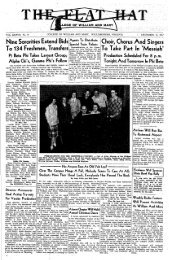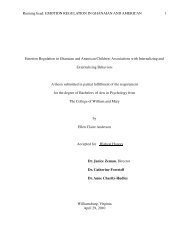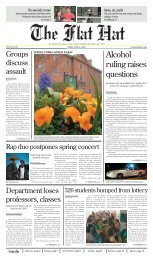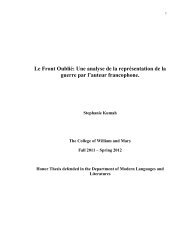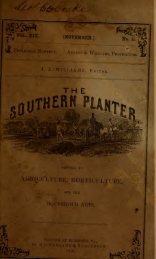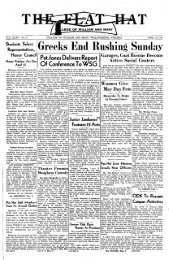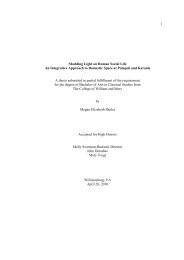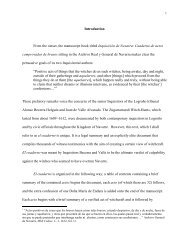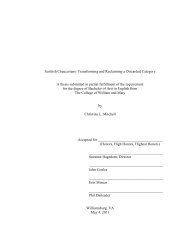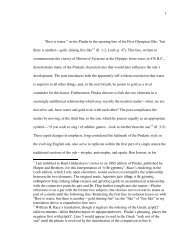Southern planter : devoted to agriculture, horticulture, and the ...
Southern planter : devoted to agriculture, horticulture, and the ...
Southern planter : devoted to agriculture, horticulture, and the ...
Create successful ePaper yourself
Turn your PDF publications into a flip-book with our unique Google optimized e-Paper software.
To Teachers.<br />
We call <strong>the</strong> attention of persons engaged in<br />
teaching <strong>to</strong> <strong>the</strong> farm No. 3, advertised by ns in<br />
our list of f\arms, <strong>to</strong> be found in our adverti-<br />
sing columns. The school has a large paying<br />
patronage, is situated in <strong>the</strong> most healthy re-<br />
gion of Virginia, <strong>and</strong> presents <strong>to</strong> persons wish-<br />
' ' iJ "" '<br />
L!!i!MJgJ!L!L. J. '<br />
ll' iiU<br />
THE SOUTHERN PLANTER, 395<br />
"" "' " !<br />
iii«j^»<br />
Inrtirulloral Iffiartramt.<br />
Whortleberries.<br />
In a paragraph in our last, we alluded <strong>to</strong><br />
<strong>the</strong> improvement of <strong>the</strong> whortleberry by cultivation,<br />
referring <strong>to</strong> an example which had<br />
been made in this vicinity. We have since<br />
met with an interesting article by Wilson<br />
Flagg, in Ilovey's Magazine of Horticulture,<br />
from which we take <strong>the</strong> following. We have<br />
long been of <strong>the</strong> opinion that <strong>the</strong> whortleberry<br />
was not duly appreciated, <strong>and</strong> trust that <strong>the</strong><br />
arguments of Mr. F. may aid in causing a<br />
more just estimate <strong>to</strong> be placed on this " native<br />
American" fruit.— [Eds.<br />
The whortleberry is strictly an American<br />
fruit; for, although it is not unknown in middle<br />
<strong>and</strong> nor<strong>the</strong>rn Europe <strong>and</strong> in some of <strong>the</strong><br />
tropical Isl<strong>and</strong>s, it is in no part of <strong>the</strong> world<br />
so abunbant as in North America. It is indeed<br />
highly probable that <strong>the</strong> whortleberry<br />
tribe of plants originated here, <strong>and</strong> from this<br />
point have spread <strong>the</strong>mselves over o<strong>the</strong>r tracts.<br />
Whortleberries, however, are most abundant<br />
near <strong>the</strong> coast, especiaily in <strong>the</strong> nor<strong>the</strong>rn parts,<br />
<strong>and</strong> form in <strong>the</strong> New Engl<strong>and</strong> States one of<br />
<strong>the</strong> principal features of <strong>the</strong> l<strong>and</strong>scape. No<br />
single species of this tribe has been reduced <strong>to</strong><br />
cultivation, though any of <strong>the</strong>m would probably<br />
well reward <strong>the</strong> labor of <strong>the</strong> cultiva<strong>to</strong>r, if<br />
<strong>the</strong>y were not abundant in a wild state. The<br />
fruit of <strong>the</strong>se plants is well known only <strong>to</strong> <strong>the</strong><br />
inhabitants of <strong>the</strong> New Engl<strong>and</strong> States ; very<br />
little has been written upon it, <strong>and</strong> <strong>the</strong>re are<br />
but few persons who are aware of <strong>the</strong> importance<br />
of this gift of Nature <strong>to</strong> <strong>the</strong> inhabitants<br />
of North America.<br />
In <strong>the</strong> study of geographical botany we find<br />
groups of certain tribes of plants prevailing<br />
over extensive tracts of country, <strong>and</strong> abounding<br />
generally in regions that are contiguous.<br />
But sometimes <strong>the</strong>y are widely separated, like<br />
<strong>the</strong> heaths which are found in Europe <strong>and</strong> in<br />
<strong>the</strong> <strong>Sou<strong>the</strong>rn</strong> part of Africa. The whortleber-<br />
ries supply in America <strong>the</strong> place of <strong>the</strong> heaths<br />
in Europe, <strong>and</strong> in no part of <strong>the</strong> world are<br />
<strong>the</strong>se two tribes found associated. The whortleberries<br />
are by far <strong>the</strong> most valuable gift of<br />
Nature of <strong>the</strong> two, being hardly less beautiful<br />
when in flower, <strong>and</strong> bearing also an excellent<br />
fruit. In this country <strong>the</strong>y are sufficiently numerous<br />
<strong>to</strong> constitute alone a distinguishing feature<br />
of <strong>the</strong> l<strong>and</strong>scape. They are most abun-<br />
ing <strong>to</strong> engage in such profession an opportudant in <strong>the</strong> nor<strong>the</strong>rn Atlantic States ; but <strong>the</strong>y<br />
nity rarely offered for a safe <strong>and</strong> profitable investment.<br />
AUGUST & WILLIAMS.<br />
See advertisement of a " Farm wanted in<br />
<strong>the</strong> Salt Water region of Virginia.'^<br />
are found along <strong>the</strong> whole coast as far as <strong>the</strong><br />
Cape of Florida. In <strong>the</strong> sou<strong>the</strong>rn States are<br />
one or two species approachins: <strong>the</strong> size of trees,<br />
one of which, called <strong>the</strong> farkleberry, {vaccinium<br />
arboreiim,) is an evergreen, <strong>and</strong> bears a<br />
very good fruit.<br />
In New Engl<strong>and</strong> we reckon about nine or<br />
ten distinct species of Vaccinium. Botanists<br />
make no generic distinction between <strong>the</strong> blueberry<br />
or bilberry, <strong>and</strong> <strong>the</strong> whortleberry ; but<br />
all who have eaten <strong>the</strong> fruit distinguish at<br />
once <strong>the</strong> whortleberry from <strong>the</strong> blueberry, by<br />
<strong>the</strong> flavor <strong>and</strong> not entirely by <strong>the</strong> color. The<br />
former is less accidulous, less mucilaginous,<br />
<strong>and</strong> contains a harder seed than <strong>the</strong> latter, so<br />
that <strong>the</strong>y may be easily distinguished, when<br />
eaten, though <strong>the</strong>ir color <strong>and</strong> external appearance<br />
are <strong>the</strong> same. I observe that Bigelow<br />
makes <strong>the</strong> distinction between <strong>the</strong>m in <strong>the</strong><br />
English names he applies <strong>to</strong> <strong>the</strong> species, while<br />
Emerson calls <strong>the</strong>m, indiscriminately, whortleberries.<br />
The flowers of <strong>the</strong> two kinds differ as<br />
widely as <strong>the</strong>ir fruits ; those of <strong>the</strong> whortleberries<br />
are more of a redish color, smaller <strong>and</strong><br />
more contracted in <strong>the</strong> mouth than those of <strong>the</strong><br />
blueberries.<br />
In <strong>the</strong> whortleberry division of this tribe of<br />
plants, are usually reckoned five species : 1.<br />
Vaccinium resinosum, which is <strong>the</strong> common<br />
whortleberry, or huckleberry. I prefer <strong>the</strong><br />
former word because it indicates its derivation<br />
from hurdle, signifying berries growing on hurdles<br />
or sticks. After <strong>the</strong> bushes were cut <strong>and</strong><br />
bound in<strong>to</strong> faggots, <strong>the</strong> berries being found<br />
upon <strong>the</strong>m gave origin <strong>to</strong> <strong>the</strong>ir name. This<br />
first species is <strong>the</strong> type of <strong>the</strong> division. 2. V.<br />
frondosum, dangle-berry, sometimes called bul-<br />
let-berries. This is a late species, but <strong>the</strong> fruit<br />
is large <strong>and</strong> finely flavored. I have found it<br />
near Bartholomew's pond in Danvers, but it is<br />
rare. 3. V. virgatum, <strong>the</strong> blue whortleberry,<br />
a species that bears more showy floAvers than<br />
<strong>the</strong> o<strong>the</strong>rs, <strong>and</strong> more elegant foliage. The fruit<br />
is not superior, however, <strong>to</strong> that of <strong>the</strong> resinosum.<br />
4. V. stamineum, green whortleberry,<br />
or deer-berry. This species is common at <strong>the</strong><br />
South, <strong>and</strong> ripens its fruit, which is inferior,<br />
in September. 5. V. dumosum, <strong>the</strong> hairy<br />
whortleb*^rry, a large shrub, with very showy<br />
floM'ers <strong>and</strong> insipid fruit.<br />
In <strong>the</strong> bilberry division, <strong>the</strong>re are four species<br />
described by botanists : 1. V. tenellum,<br />
<strong>the</strong> low blueberry, which bears <strong>the</strong> earliest <strong>and</strong><br />
most beautiful fruit of <strong>the</strong> whole tribe, <strong>and</strong> is<br />
<strong>the</strong> smallest shrub of <strong>the</strong> genus. 2. The high-



